Madison Metro
Metro Transit operates a bus service throughout the City of Madison, Wisconsin, United States and most of its immediate suburbs, including the City of Middleton, Fitchburg, Maple Bluff, Shorewood Hills, Sun Prairie, Verona, and a small portion of McFarland.[1] System-wide, fixed route ridership was 13,385,628 in 2018.[2] Metro Transit also provides supplemental transit services to some Madison middle and high schools. Several schools have switched to yellow buses in 2019. These routes are open to the general public, but have been designed to provide additional services during peak school times.[3] Metro Transit also serves the University of Wisconsin–Madison campus, Eagle Heights University apartments, and some off-campus residential areas, via routes 80, 81, 82, and 84. The "80 routes" are free of charge.[4]
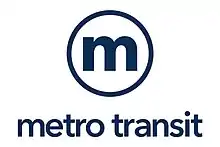 | |
| Parent | City of Madison |
|---|---|
| Headquarters | 1245 E. Washington Ave. |
| Locale | Madison, Wisconsin |
| Service area | 72 square miles |
| Service type | Bus service, Paratransit |
| Destinations | Fitchburg, Maple Bluff, Middleton, Shorewood Hills, Verona, McFarland, Sun Prairie |
| Hubs |
|
| Fleet | 215 fixed-route buses, 20 paratransit vehicles |
| Annual ridership | 12,856,541 (2019) 4,693,090 (2020) |
| Fuel type | Low Sulfur diesel, Hybrid diesel-electric, and some battery-operated electric buses (active 2020) |
| Operator | City of Madison |
| General Manager | Justin Stuehrenberg |
| Website | www |
Metro also connects with suburban mass transit services, such as the Monona Lift/Monona Express and Sun Prairie Shared Taxi Shuttle.[5]
History
Before the city of Madison established a public transit agency, bus service in the city was operated by a private firm, the Madison Bus Company. After the company's revenues fell and the quality of service declined in the 1960s, the city agreed to purchase the Madison Bus Company, with the acquisition taking effect on May 1, 1970.[6]
Madison Metro's routes were dramatically overhauled on July 19, 1998. Previously, all routes had passed through Capitol Square, making downtown the only interchange point for cross-town travel. The 1998 changes redesigned the entire network around four newly-created "transfer points" on the north, east, south, and west sides of the city. The number of routes nearly doubled, from 23 to 43. Additionally, while the old routes had been indicated with letters, the new routes were given numbers to illustrate that they had no connection to the previous network.[7] This transfer point system had been proposed as early as 1970, while the city was in the process of acquiring the bus company, by city council candidate Audrey Parkinson.[8]
On June 11, 2023, the route network was overhauled to one with fewer routes and more frequent service.[9] The four transfer points were eliminated from the network, The change has had a mixed reception; some have praised the redesign for more frequent service with less transfers, while others have criticized the redesign for eliminating service where the elderly, disabled, and low-income populations used to be able to ride the bus.[10][11]
Bus rapid transit
Madison Metro is also creating a bus rapid transit system, slated to open in late 2024.[12] Buses will arrive on BRT lines every 5-15 minutes on weekdays.[13]
Route network
The transit network focuses on point-to-point service with some routes having different destinations but sharing the same core segments. Many routes serve downtown Madison and the University of Wisconsin–Madison where transit usage is high.
The vast majority of service updates reflected in this section went into effect in June 2023. Significant changes include the restructuring of the main route network, including the discontinuation of the previous transfer point system, and the reintroduction of lettered routes replacing the previous numbering system. Although a small amount of weekday commuter routes remain numbered for administrative reasons.[14] The University of Wisconsin circulator network was largely unaffected by the changes and retain its previous numbers/ routes.[15][16]
Regular routes
All routes in the table below run daily with varying service levels given the time/day. For example, route B runs every 15 minutes on weekdays, but every 30 minutes during evenings and weekends.
| Route | Terminals[note 1] | Major streets[note 2] | Notes | |
|---|---|---|---|---|
| A | Junction & Watts | 1: Sun Prairie Park & Ride | East Springs Dr, High Crossing Blvd | Future BRT route |
| 2: American Center/Hanson Rd | American Pkwy, Eastpark Blvd | |||
| B | Fitchburg/Cahill Main | Northport Dr | Fish Hatchery Rd, Park St, Packers Ave | Future BRT route |
| C | UW Hospital/Highland Ave | 1: Sprecher & Cottage Grove | Old University Ave, King St, Wilson St, Jenifer St, Winnebago St, Atwood Ave | |
| 2: Buckeye Rd | ||||
| D | 1: Junction & Watts | Sprecher & Cottage Grove | Schroeder Rd, Tokay Blvd, Odana Rd, Milwaukee St | |
| 2: McKee & Maple Grove | Airport/International Ln | Fitchrona Rd, Williamsburg Way, Allied Dr, Nakoma Rd, Sherman Ave | ||
| E | McKee Rd | Capitol Square | Raymond Rd, Whitney Way, Mineral Point Rd, Regent St, W. Washington Ave | |
| F | Junction Rd - Middleton | Sheboygan Ave - Capitol Square | Deming Way, University Ave, Parmenter St, Century Ave, Allen Blvd, Sheboygan Ave | Future BRT route |
| G | South Transfer Point | East Towne Mall/Independence Ln | Badger Rd, South Towne Dr, E. Broadway, Monona Dr (no stops), Dempsey Rd, Thompson Rd, Eagan Rd | |
| H | West Towne Mall/Westfield Rd | South Transfer Point | Gammon Rd, McKenna Blvd, Raymond Rd, Todd Dr, Fish Hatchery Rd, Badger Rd | |
| J | West Towne Mall/Westfield Rd | Park St/Brooks & Johnson | Odana Rd, Tokay Blvd, Speedway Rd, Highland Ave/UW Hospital | |
| L | Femrite & Agriculture | Sherman & Delaware | Owl Creek Rd, Dutch Mill Rd, Agriculture Dr, Pflaum Rd, Atwood Ave, Sherman Ave | |
| O | South Transfer Point | Park St/Brooks & Johnson | Badger Rd, Fish Hatchery Rd, Randall Ave, Olin Ave, John Nolen Dr, Rimrock Rd | |
| R | 1: Junction & Watts | Sheboygan Ave - Capitol Square | High Point Rd, Old Sauk Rd, Old Middleton Rd | |
| 2: South Ridge/Highway Q & Century Ave | Century Ave, University Ave, Gammon Rd | |||
Weekday peak-only routes
| Route | Terminals | Major Streets[note 3] | Notes | |
|---|---|---|---|---|
| 28 | UW Hospital | Sherman Ave | Observatory Dr/UW Campus, Charter St, Fordem Ave | |
| 38 | UW Hospital | Jenifer & Ingersoll | Babcock Dr/UW Campus, Bassett St, Broom St, Wilson St, Doty St, Williamson St | |
| 55 | Junction & Watts | Epic Campus | High Point Rd, Mid Town Rd, Northern Lights Rd | |
| 65 | UW Hospital | Fitchburg | John Nolen Dr, Rimrock Rd, Lacy Rd, E. Cheryl Pkwy | |
| 75 | Epic Campus/Verona | Capitol Square | Verona Ave, McKee Rd, Fish Hatchery Rd, Park St | |
- Routes may have multiple start/end points.
- Sections of roads with more than two concurrent routes are generally omitted for conciseness.
- Sections of roads with more than two concurrent routes are generally omitted for conciseness.
Sun Prairie circulator service
Madison Metro provides two local bus routes within the City of Sun Prairie. Both routes run on a looping circulator system beginning and ending at the Sun Prairie Park and Ride.[17][18]
- S O'Keeffe Ave, Main St, Bristol St, Tower Dr, Windsor Ave, Grand Ave (anti-clockwise loop) (daily)
- W Grand Ave, Main St, US 151 (no stops), Windsor Ave, Bird St, O'Keeffe Ave (clockwise loop) (weekdays)
UW–Madison campus buses
All routes in this section are fare free. Operating costs are paid by Associated Students of Madison, UW Transportation Services, and University Housing. When UW–Madison is out of session, route 80 and 84 service is reduced and routes 81 and 82 do not run.[19]
- 80 Memorial Union - Eagle Heights (weekday, weekends, and late night)
- 81 Park, Broom, Johnson/Gorham Loop(s) (evening and late night)
- 82 Observatory, Breese Loop(s) (evening and late night)
- 84 Eagle Heights Express (limited stops) weekdays only
Supplemental schoolday service
- 60 - East High School District
- 61 - La Follette High School District
- 62 - Memorial High School District
- 63 - West High School District
- 64 - Capital High School District
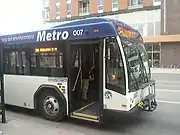
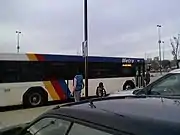
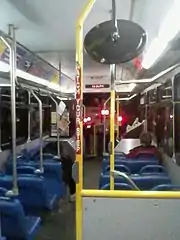
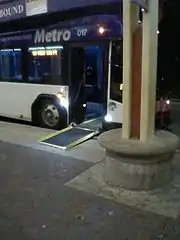
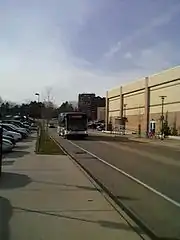
Bus fleet
- 800-875 New Flyer D40LF (Most have been retired, Main use for school service and extra buses)
- 876-999, 100-160 Gillig Advantage (several of the oldest in the fleet have been retired).
- 001-021 Gillig/GM/Allison (Gillig BRT Hybrid)[20]
- 1901-1915 New Flyer Xcelsior (40' ft) added in 2019.
- 2001-2003 Proterra, Inc. Electric Buses, joined fleet in the summer of 2020,[21] began service late 2022.
- 2004-2015 New Flyer Xcelsior (40' ft) added in 2020.
- 2201-2215 New Flyer Xcelsior (40' ft) added in 2022.
Several of the buses have pictures of famous art hanging in them.
- 108 - American Gothic by Grant Wood
- 138 - Old Guitarist by Pablo Picasso
- 949 - Three Musicians by Pablo Picasso
- 955 - Head of a Woman by Pablo Picasso
- 991 - Girl with a Pearl Earring by Johannes Vermeer, Three Musicians by Pablo Picasso
- 2204 - Starry Night by Vincent van Gogh
- 2205 - Self Portrait by Vincent van Gogh
- 2208 - Girl with a Pearl Earring by Johannes Vermeer
Future fleet
- 46 New Flyer Xcelsior 60-foot battery electric buses; will be used on a new Bus Rapid Transit line in 2024.[22]
Ridership
| Ridership | Change over previous year | |
|---|---|---|
| 2013[23] | 15,001,760 | n/a |
| 2014[24] | 15,492,317 | |
| 2015[25] | 14,632,229 | |
| 2016[26] | 13,584,517 | |
| 2017[27] | 13,108,095 | |
| 2018[28] | 13,385,628 | |
| 2019[29] | 12,969,815 | |
| 2020[30] | 4,755,375 | |
| 2021[31] | 5,458,011 | |
Gallery
 Metro bus on State Street
Metro bus on State Street A Madison Metro bus stop sign
A Madison Metro bus stop sign The front of a Metro Gillig BRT hybrid bus
The front of a Metro Gillig BRT hybrid bus Inside a hybrid bus at night
Inside a hybrid bus at night.jpg.webp) Madison Metro bus
Madison Metro bus.jpg.webp) Metro Transit maintenance facility
Metro Transit maintenance facility
See also
References
- Madison Metro Transit (2018). "Madison Metro System Maps". City of Madison. Archived from the original on January 19, 2019. Retrieved January 17, 2019.
- Staff (2018). "2018 Annual Report" (PDF). Metro Transit. City of Madison, WI. Archived (PDF) from the original on March 27, 2020. Retrieved May 11, 2020.
- "Supplemental School Service". Metro Transit - City of Madison, Wisconsin. Archived from the original on July 19, 2012. Retrieved August 7, 2012.
- "Bus Routes". wisc.edu. Archived from the original on March 27, 2012. Retrieved September 4, 2012.
- "Sun Prairie Taxi Service - Routes & Schedules". Metro Transit - City of Madison, Wisconsin. Archived from the original on September 26, 2012.
- Foley, Tom. "Bus Drivers Still Don't Know Who The Boss Is", Madison Capital Times, April 30, 1970, page 29.
- Hall, Dee J., Phil Brinkman, and Valeria Davis-Humphrey. "Know where you're going?", Wisconsin State Journal, July 21, 1998, front page and page 4A.
- "10th Ward Candidate Urges Route Overhaul for Buses", Madison Capital Times, February 2, 1970, page 3.
- Kowles, Naomi (March 30, 2022). "Fewer routes, more rides: Madison's bus route redesign has some elderly, disabled concerned". Channel3000.com. Archived from the original on February 19, 2023. Retrieved February 19, 2023.
- Kowles, Naomi (April 26, 2022). "Madison fields thousands of suggestions, complaints, input on Metro Transit redesign". WMSN. Archived from the original on April 27, 2022. Retrieved February 19, 2023.
- Kowles, Naomi. "ACLU Wisconsin to Madison Metro: Concerns about transit redesign's compliance with federal law". Channel3000.com. Archived from the original on February 19, 2023. Retrieved February 19, 2023.
- Lehr, Sarah (December 15, 2022). "Madison promises fewer stops, shorter commutes as plans for bus rapid transit roll ahead". Wisconsin Public Radio. Archived from the original on December 21, 2022. Retrieved February 19, 2023.
- Degnan, Maggie (September 29, 2021). "City of Madison surges forward with Bus Rapid Transit plans despite some local businesses' opposition". The Badger Herald. Archived from the original on May 29, 2022. Retrieved February 19, 2023.
- "Transit Network Redesign | Metro Transit, City of Madison, Wisconsin".
- "UW Service Calendar | Metro Transit, City of Madison, Wisconsin".
- "Campus and City Bus Routes - UW Madison". Transportation Services. Retrieved July 4, 2023.
- "Metro Transit Service to Sun Prairie". City of Sun Prairie.
- Peters, Tyler (January 21, 2023). "Sun Prairie to join Madison Metro's Bus Rapid Transit system". Retrieved July 5, 2023.
- "UW Service Calendar". Metro Transit. Archived from the original on December 19, 2019. Retrieved December 19, 2019.
- Staff (2010). "METRO HYBRID BUSES". Metro Transit. City of Madison, WI. Archived from the original on May 14, 2012. Retrieved July 1, 2012.
- Garfield, Allison (August 15, 2022). "The bumpy road to electric buses in Madison". The Cap Times. Archived from the original on October 13, 2022. Retrieved February 19, 2023.
- "New Flyer will deliver 46 e-buses to Metro Transit for the city of Madison". Sustainable Bus. January 10, 2023. Archived from the original on January 13, 2023. Retrieved February 19, 2023.
- "2013 Metro Transit System profile" (PDF), transit.dot.gov, archived (PDF) from the original on April 2, 2022, retrieved April 2, 2022
- "2014 Metro Transit System profile" (PDF), transit.dot.gov, archived (PDF) from the original on April 2, 2022, retrieved April 2, 2022
- "2015 Metro Transit System profile" (PDF), transit.dot.gov, archived (PDF) from the original on February 19, 2023, retrieved April 2, 2022
- "2016 Metro Transit System profile" (PDF), transit.dot.gov, archived (PDF) from the original on April 2, 2022, retrieved April 2, 2022
- "2017 Metro Transit System profile" (PDF), transit.dot.gov, archived (PDF) from the original on April 2, 2022, retrieved April 2, 2022
- "2018 Metro Transit System profile" (PDF), transit.dot.gov, archived (PDF) from the original on April 2, 2022, retrieved April 2, 2022
- "2019 Metro Transit System profile" (PDF), transit.dot.gov, archived (PDF) from the original on February 4, 2022, retrieved April 2, 2022
- "2020 Metro Transit System profile" (PDF), transit.dot.gov, archived (PDF) from the original on April 2, 2022, retrieved April 2, 2022
- "2021 Metro Transit System profile" (PDF), transit.dot.gov, archived (PDF) from the original on February 5, 2023, retrieved February 5, 2023
External links
- Metro Transit website
- Public Transit Data and Trends from the Madison Area Metropolitan Planning Organization